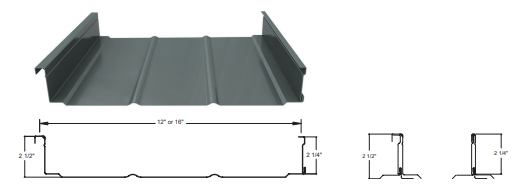BRETT in CUMBERLAND FURNACE writes:
“I was talking to a contractor and he really thinks it is a big mistake to use a 26 gauge thickness vs a 24 gauge. He is stating “I will have less issue with oil canning and it will look a lot better for the extra cost over the life of the roof. I don’t think Fabral even makes a 24 gauge for this roof panel. Any thoughts to his statement?”
Mike the Pole Barn Guru says:
If I would not have recently sold our home near Spokane, Washington I would have re-roofed it with 24 gauge standing seam steel panels. This thickness was not determined by avoiding oil canning, it was a function of being able to get my color choice with Kynar paint.

Fabral Stand N Seam
Oil canning in metal roofing is an observed waviness or buckling across sheet metal panels not normally affecting a roof’s structural integrity. While sometimes caused by inferior metal or too-low-gauge thickness, too often, it is caused by under- or over-tightening of roof fasteners causing metal roofing to stretch, pull and dimple in various directions. An over-tightened fastener will pull cladding down locally and can create deformations. Generally speaking, thicker metal means less likelihood there will be oil-canning. Other causes include:
• Uneven substrate
• Width and spacing of seam
Don’t start a panel installation out of square. Leave room for thermal expansion at eaves to lessen oil canning. Most panels accommodate transverse thermal expansion by flexing of webs and by “take-up” at sidelaps. When panels are over-tightened, these relief features are hindered or eliminated, particularly for flat panels without corrugations.
Substrates are often a source of oil canning. Substrate must be made of a material, or set of materials, not adhering to metal underside or restricting metal’s normal thermal movements. Deck deviation, bows, ridges and camber all induce stress in finished panel installation. Substrate needs to be in a level plane. Make sure the substrate has no defections and shim panels when needed. Also, “slip sheets” between metal and underlayment can prevent oil canning. Some underlayments have a surface acting as a slip sheet.
Improper storing, handling, carrying and installing panels can contribute to oil canning. Twisting, buckling and other mishandling of panels can introduce oil canning into a previously flat panel.
Narrower width panels help to alleviate the appearance of oil canning. Darker colors accentuate oil canning, while earth-tone colors hide it best.






